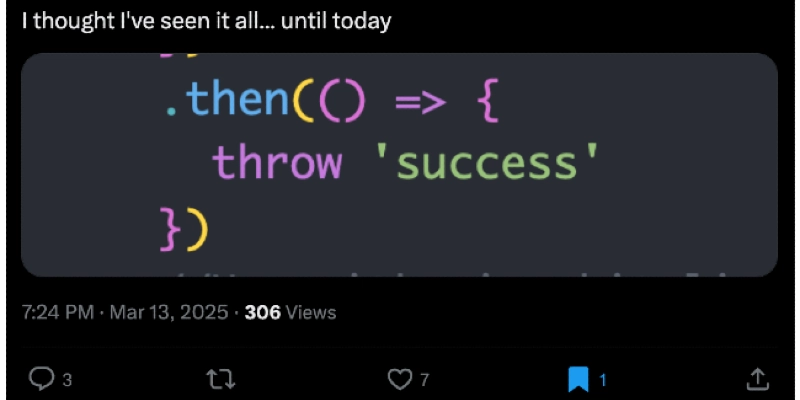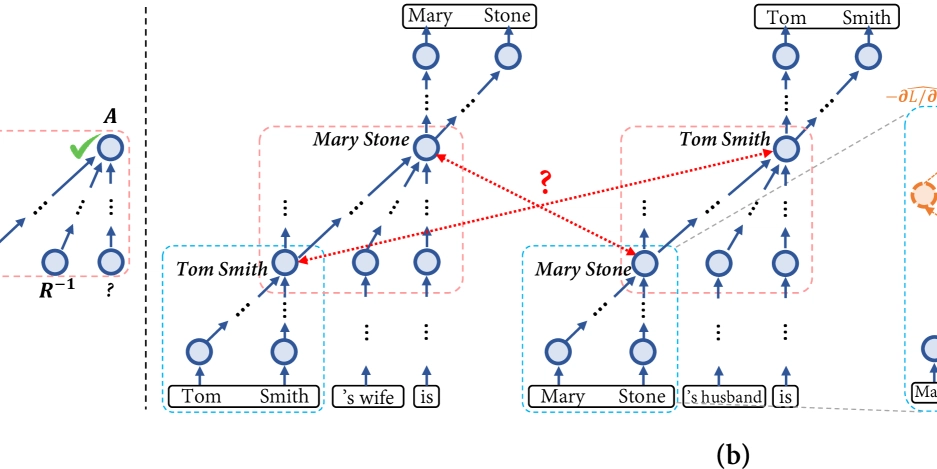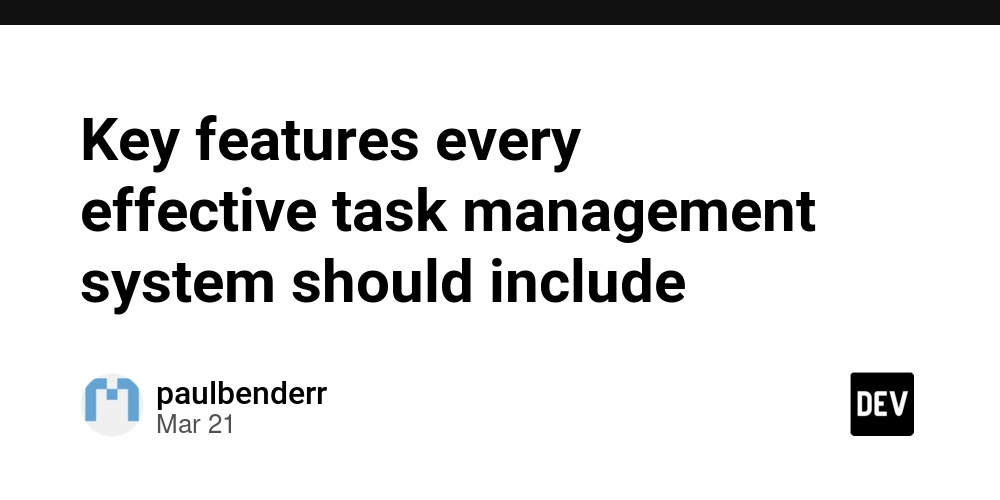How JavaScript Lost Its Way With Error Handling (Can We Fix It?)
JavaScript Errors Used to Be Simple We had a dedicated channel in callbacks. We knew when something went wrong for that function. fs.readFile('file.txt', (err, data) => { if (err) { console.error(err); return; } console.log(data); }); You checked for the error. You dealt with it. No surprises. No magic. It wasn’t pretty, because callback hell. But it was clear. Then Came Async/Await It looked clean. Linear. Easy to follow. Arguably, it still is. But we started throwing errors again. All in the same channel. Like this: fastify.get('/user/:id', async (req, reply) => { const user = await getUser(req.params.id); if (!user) throw fastify.httpErrors.notFound(); return user; }); This seems fine—until you need to do more than one thing. Suddenly, your catch block becomes a patchwork of if-statements: fastify.get('/user/:id', async (req, reply) => { try { const user = await getUser(req.params.id); if (!user) throw fastify.httpErrors.notFound(); const data = await getUserData(user); return data; } catch (err) { if (err.statusCode === 404) { req.log.warn(`User not found: ${req.params.id}`); return reply.code(404).send({ message: 'User not found' }); } if (err.statusCode === 401) { req.log.warn(`Unauthorized access`); return reply.code(401).send({ message: 'Unauthorized' }); } req.log.error(err); return reply.code(500).send({ message: 'Unexpected error' }); } }); You're using catch not just for exceptions, but for expected things: A user not found Invalid auth Bad input You're forced to reverse-engineer intent from the thrown error. You lose clarity. You lose control. Other Languages Seem To Do Better Go Go keeps it simple. Errors are values. data, err := ioutil.ReadFile("file.txt") if err != nil { log.Fatal(err) } You deal with the error. Or you don’t. But you don’t ignore it. Scala Scala uses types to make the rules clear. val result: Either[Throwable, String] = Try { Files.readString(Path.of("file.txt")) }.toEither result match { case Left(err) => println(s"Error: $err") case Right(data) => println(s"Success: $data") } You must handle both outcomes. No free passes. No silent failures. Use Option for missing values. val maybeValue: Option[String] = Some("Hello") val result = maybeValue.getOrElse("Default") No null. No undefined. No guessing. What JavaScript Could Be We don’t have to do this: try { const data = await fs.promises.readFile('file.txt'); } catch (err) { console.error(err); } We could do this: const [err, data] = await to(fs.promises.readFile('file.txt')); if (err) { console.error('Failed to read file:', err); return; } console.log('File contents:', data); It’s clear. It’s honest. It works. Or we use a result wrapper: const result = await Result.try(() => fs.promises.readFile('file.txt')); if (result.isErr) { console.error(result.error); } else { console.log(result.value); } You know what's expected. You know what blew up. Want to Write Better Code? Here are some tools to help with that: await-to-js — [err, data] pattern neverthrow — type-safe error handling oxide.ts — Rust-style Result and Option types for TypeScript One Last Thing This is a bit of the old “you made your bed, now lie in it.” We started throwing everything into a single channel. We didn’t think it through. But it’s fixable. Choose better patterns. Throw less. Write what you mean.

JavaScript Errors Used to Be Simple
We had a dedicated channel in callbacks. We knew when something went wrong for that function.
fs.readFile('file.txt', (err, data) => {
if (err) {
console.error(err);
return;
}
console.log(data);
});
You checked for the error. You dealt with it.
No surprises. No magic.
It wasn’t pretty, because callback hell. But it was clear.
Then Came Async/Await
It looked clean. Linear. Easy to follow. Arguably, it still is.
But we started throwing errors again. All in the same channel.
Like this:
fastify.get('/user/:id', async (req, reply) => {
const user = await getUser(req.params.id);
if (!user) throw fastify.httpErrors.notFound();
return user;
});
This seems fine—until you need to do more than one thing.
Suddenly, your catch block becomes a patchwork of if-statements:
fastify.get('/user/:id', async (req, reply) => {
try {
const user = await getUser(req.params.id);
if (!user) throw fastify.httpErrors.notFound();
const data = await getUserData(user);
return data;
} catch (err) {
if (err.statusCode === 404) {
req.log.warn(`User not found: ${req.params.id}`);
return reply.code(404).send({ message: 'User not found' });
}
if (err.statusCode === 401) {
req.log.warn(`Unauthorized access`);
return reply.code(401).send({ message: 'Unauthorized' });
}
req.log.error(err);
return reply.code(500).send({ message: 'Unexpected error' });
}
});
You're using catch not just for exceptions, but for expected things:
- A user not found
- Invalid auth
- Bad input
You're forced to reverse-engineer intent from the thrown error.
You lose clarity. You lose control.
Other Languages Seem To Do Better
Go
Go keeps it simple. Errors are values.
data, err := ioutil.ReadFile("file.txt")
if err != nil {
log.Fatal(err)
}
You deal with the error. Or you don’t. But you don’t ignore it.
Scala
Scala uses types to make the rules clear.
val result: Either[Throwable, String] = Try {
Files.readString(Path.of("file.txt"))
}.toEither
result match {
case Left(err) => println(s"Error: $err")
case Right(data) => println(s"Success: $data")
}
You must handle both outcomes.
No free passes. No silent failures.
Use Option for missing values.
val maybeValue: Option[String] = Some("Hello")
val result = maybeValue.getOrElse("Default")
No null. No undefined. No guessing.
What JavaScript Could Be
We don’t have to do this:
try {
const data = await fs.promises.readFile('file.txt');
} catch (err) {
console.error(err);
}
We could do this:
const [err, data] = await to(fs.promises.readFile('file.txt'));
if (err) {
console.error('Failed to read file:', err);
return;
}
console.log('File contents:', data);
It’s clear. It’s honest. It works.
Or we use a result wrapper:
const result = await Result.try(() => fs.promises.readFile('file.txt'));
if (result.isErr) {
console.error(result.error);
} else {
console.log(result.value);
}
You know what's expected. You know what blew up.
Want to Write Better Code?
Here are some tools to help with that:
-
await-to-js—[err, data]pattern -
neverthrow— type-safe error handling -
oxide.ts— Rust-styleResultandOptiontypes for TypeScript
One Last Thing
This is a bit of the old “you made your bed, now lie in it.”
We started throwing everything into a single channel.
We didn’t think it through.
But it’s fixable.
Choose better patterns.
Throw less.
Write what you mean.










































































































































































![[The AI Show Episode 142]: ChatGPT’s New Image Generator, Studio Ghibli Craze and Backlash, Gemini 2.5, OpenAI Academy, 4o Updates, Vibe Marketing & xAI Acquires X](https://www.marketingaiinstitute.com/hubfs/ep%20142%20cover.png)














































































































































































































































.jpg?#)















































































































































![YouTube Announces New Creation Tools for Shorts [Video]](https://www.iclarified.com/images/news/96923/96923/96923-640.jpg)

![Apple Faces New Tariffs but Has Options to Soften the Blow [Kuo]](https://www.iclarified.com/images/news/96921/96921/96921-640.jpg)
































































































































